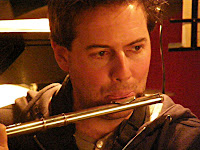 I realised while I was amongst the live sound of Ben Marston’s Quartet going live to air on ArtSound that I was privileged to be there. To hear the banter and reasonably controlled confusion that exists around the professionalism and impressiveness of the music itself. This is music speaking for itself. The band didn’t even know what they were to play for the last tune, but who’d know (other than because they said so to the listening audience, of course). These guys know each other after years of a weekly residency and although it finished 4 years ago, it’s still there in their interactions and their bumptious joy in performing their electric versions of some very well known standards. Although well known, some purists might not recognise Miles in this concoction. But I reckon Miles would enjoy the musical humour and coquettishness of it all.
I realised while I was amongst the live sound of Ben Marston’s Quartet going live to air on ArtSound that I was privileged to be there. To hear the banter and reasonably controlled confusion that exists around the professionalism and impressiveness of the music itself. This is music speaking for itself. The band didn’t even know what they were to play for the last tune, but who’d know (other than because they said so to the listening audience, of course). These guys know each other after years of a weekly residency and although it finished 4 years ago, it’s still there in their interactions and their bumptious joy in performing their electric versions of some very well known standards. Although well known, some purists might not recognise Miles in this concoction. But I reckon Miles would enjoy the musical humour and coquettishness of it all.


 Needless to say, I enjoyed Ben’s band immensely. Ben played a clean sounding trumpet or flugelhorn, but it sat neatly with clear solo lines and occasional flourishes. James toys with us, with the deepest of sub-bass sounds and Pastorian chords and a delightfully unsustained, string slapping sound on his home-defretted 5-string Fender jazz. Lachlan riffs richly with those fast lines that guitarists do, reminiscing on the US West Coast sounds of recent years, with just an edge of distortion. Chris was blissful in his so apt but so modular yet fluid patterns, and his zen-like appreciation of the ringing of cymbals. I remember a one-note passage in a solo by James on All the things you are that just moved the dots around the bars. Just lovely, and so playful. Then a heart-beating rhythm on the lowest of bass tones (down deep to 20Hz and thereabouts) and a steady, then simple but pure drum solo.
Needless to say, I enjoyed Ben’s band immensely. Ben played a clean sounding trumpet or flugelhorn, but it sat neatly with clear solo lines and occasional flourishes. James toys with us, with the deepest of sub-bass sounds and Pastorian chords and a delightfully unsustained, string slapping sound on his home-defretted 5-string Fender jazz. Lachlan riffs richly with those fast lines that guitarists do, reminiscing on the US West Coast sounds of recent years, with just an edge of distortion. Chris was blissful in his so apt but so modular yet fluid patterns, and his zen-like appreciation of the ringing of cymbals. I remember a one-note passage in a solo by James on All the things you are that just moved the dots around the bars. Just lovely, and so playful. Then a heart-beating rhythm on the lowest of bass tones (down deep to 20Hz and thereabouts) and a steady, then simple but pure drum solo.The tunes are ones we all know (although not Material girl this night; their locally famed adaption of Madonna’s magnus opus): Blue monk; a 25 minute medley of Third rock from the sun, All the things you are, Nica’s dream and Nardis; Solar. Ben’s original, Accidental instigation, is obviously not so well known, but it sat perfectly comfortably in this lofty company.
Comtemporary jazz is all things to whoever wishes to listen. I’ve just heard a CD from a tuba / clarinet / banjo / drums outfit from Sydney, and it’s witty and humorous and I enjoyed it immensely (The fantastic terrific Munkle). This is more electric, Pastorian, so hitting on the fusion scene, but with similar, ironic, pomo credentials. See this band, as Trident or Quadrant or Ben Marston’s Quartet or however they name themselves on the day. They are a local jazz institution and not to be missed. It’ll be a privilege for you, too.
Ben Marston (trumpet) played with Lachlan Coventry (guitar), James Luke (bass) and Chris Thwaite (drums).















































